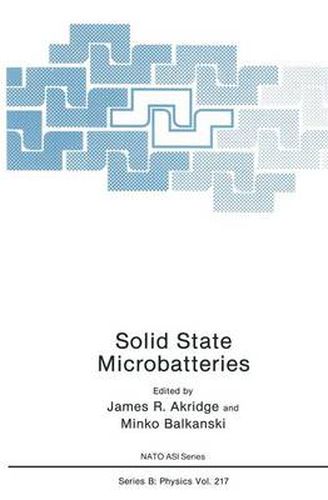Readings Newsletter
Become a Readings Member to make your shopping experience even easier.
Sign in or sign up for free!
You’re not far away from qualifying for FREE standard shipping within Australia
You’ve qualified for FREE standard shipping within Australia
The cart is loading…






This title is printed to order. This book may have been self-published. If so, we cannot guarantee the quality of the content. In the main most books will have gone through the editing process however some may not. We therefore suggest that you be aware of this before ordering this book. If in doubt check either the author or publisher’s details as we are unable to accept any returns unless they are faulty. Please contact us if you have any questions.
This Advanced Study Institute on the topic of SOLID STATE MICROBATTERIES is the third and final institute on the general theme of a field of study now termed SOLID STATE IONICS . The institute was held in Erice, Sicily, Italy, 3 - 15 July 1988. The objective was to assemble in one location individuals from industry and academia expert in the fields of microelectronics and solid state ionics to determine the feasibility of merging a solid state microbattery with microelectronic memory. Solid electrolytes are in principle amenable to vapor deposition, RF or DC sputtering, and other techniques used to fabricate microelectronic components. A solid state microbattery 1 1 mated on the same chip carrier as the chip can provide on board memory backup power. A solid state microbattery assembled from properly selected anode/solid electrolyte/cathode materials could have environmental endurance properties equal or superior to semiconductor memory chips. Lectures covering microelectronics, present state-of-art solid state batteries, new solid electrolyte cathode materials, theoretical and practical techniques for fabrication of new solid electrolytes, and analytical techniques for study of solid electrolytes were covered. Several areas where effort is required for further understanding of materials in pure form and their interactions with other materials at interfacial contact points were identified. Cathode materials for solid state batteries is one particular research area which requires attention. Another is a microscopic model of conduction in vitreous solid electrolytes to enhance the thermodynamic macroscopic Weak ~lectrolyte Iheory (WET).
$9.00 standard shipping within Australia
FREE standard shipping within Australia for orders over $100.00
Express & International shipping calculated at checkout
This title is printed to order. This book may have been self-published. If so, we cannot guarantee the quality of the content. In the main most books will have gone through the editing process however some may not. We therefore suggest that you be aware of this before ordering this book. If in doubt check either the author or publisher’s details as we are unable to accept any returns unless they are faulty. Please contact us if you have any questions.
This Advanced Study Institute on the topic of SOLID STATE MICROBATTERIES is the third and final institute on the general theme of a field of study now termed SOLID STATE IONICS . The institute was held in Erice, Sicily, Italy, 3 - 15 July 1988. The objective was to assemble in one location individuals from industry and academia expert in the fields of microelectronics and solid state ionics to determine the feasibility of merging a solid state microbattery with microelectronic memory. Solid electrolytes are in principle amenable to vapor deposition, RF or DC sputtering, and other techniques used to fabricate microelectronic components. A solid state microbattery 1 1 mated on the same chip carrier as the chip can provide on board memory backup power. A solid state microbattery assembled from properly selected anode/solid electrolyte/cathode materials could have environmental endurance properties equal or superior to semiconductor memory chips. Lectures covering microelectronics, present state-of-art solid state batteries, new solid electrolyte cathode materials, theoretical and practical techniques for fabrication of new solid electrolytes, and analytical techniques for study of solid electrolytes were covered. Several areas where effort is required for further understanding of materials in pure form and their interactions with other materials at interfacial contact points were identified. Cathode materials for solid state batteries is one particular research area which requires attention. Another is a microscopic model of conduction in vitreous solid electrolytes to enhance the thermodynamic macroscopic Weak ~lectrolyte Iheory (WET).